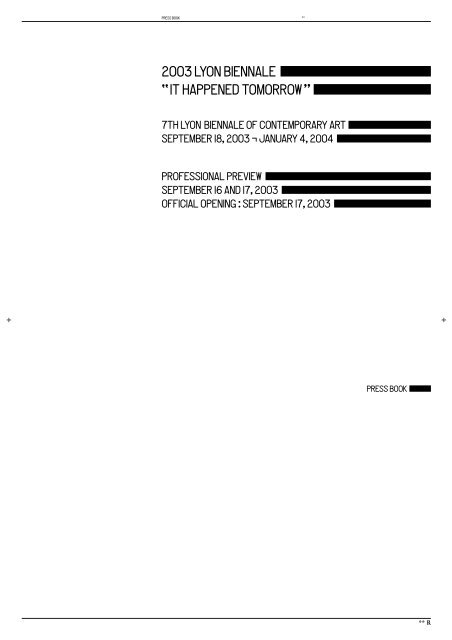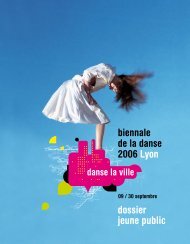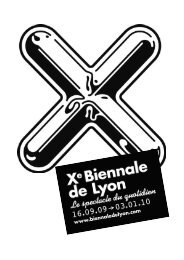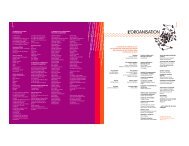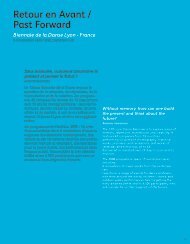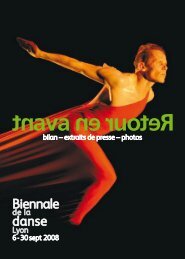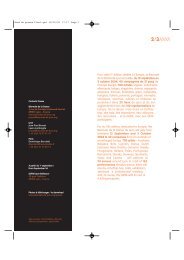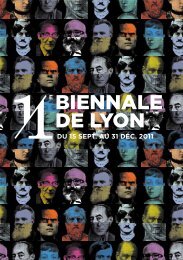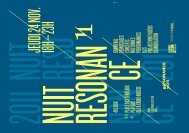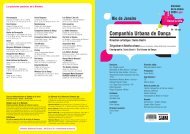english press book - Biennale d'Art Contemporain de Lyon 2003
english press book - Biennale d'Art Contemporain de Lyon 2003
english press book - Biennale d'Art Contemporain de Lyon 2003
Create successful ePaper yourself
Turn your PDF publications into a flip-book with our unique Google optimized e-Paper software.
PRESS BOOK **<br />
<strong>2003</strong> LYON BIENNALE<br />
“ IT HAPPENED TOMORROW ”<br />
7TH LYON BIENNALE OF CONTEMPORARY ART<br />
SEPTEMBER 18, <strong>2003</strong> ¬ JANUARY 4, 2004<br />
PROFESSIONAL PREVIEW<br />
SEPTEMBER 16 AND 17, <strong>2003</strong><br />
OFFICIAL OPENING : SEPTEMBER 17, <strong>2003</strong><br />
PRESS BOOK<br />
** R
THE <strong>2003</strong> LYON BIENNALE | “ IT HAPPENED TOMORROW ” **<br />
NATIONAL AND INTERNATIONAL PRESS<br />
Claudine Colin Communication<br />
Nathalie Marchal<br />
5, rue Barbette<br />
75003 Paris<br />
Phone: +33 (0)1 42 72 60 01<br />
Fax: +33 (0)1 42 72 50 23<br />
nathalie@claudinecolin.com<br />
LOCAL PRESS<br />
Les <strong>Biennale</strong>s <strong>de</strong> <strong>Lyon</strong><br />
Laura Lamboglia<br />
3, rue du Prési<strong>de</strong>nt Edouard Herriot<br />
BP 1137 – 69203 <strong>Lyon</strong> Ce<strong>de</strong>x 01<br />
Phone: +33 (0)4 72 07 41 41<br />
Cel: +33 (0)6 83 27 84 46<br />
<strong>press</strong>e.art@biennale-<strong>de</strong>-lyon.org<br />
GRAPHIC DESIGN : DENIS MATHIEU, BIENNALES<br />
PRINTING : IDMM - IMPRIMERIE DES MONTS D’OR<br />
** **
PRESS BOOK **<br />
PART 1<br />
THE LYON BIENNALE 2<br />
THE <strong>2003</strong> CURATORS 3<br />
THE <strong>2003</strong> ARTISTIC ENTERPRISE 4<br />
THE ARTISTS 5<br />
THE BIENNALE POSTER, M/M (PARIS) 13<br />
THROUGHGOING CHANGE 14<br />
VENUES 14<br />
NEW WAYS OF GETTING AROUND 15<br />
PUBLIC PROGRAMMES DEPARTMENT 16<br />
FORMER BIENNALES 17<br />
AROUND THE BIENNALE 18<br />
WHO'S WHO AT THE BIENNALE 20<br />
USEFUL INFORMATION 21<br />
PART 2<br />
THE PARTNERS OF THE LYON BIENNALE<br />
1
THE <strong>2003</strong> LYON BIENNALE | “ IT HAPPENED TOMORROW ” **<br />
THE LYON BIENNALE<br />
ARTISTIC DIRECTOR: THIERRY RASPAIL<br />
Twenty years ago the international art scene comprised four or five<br />
major events.<br />
Today our planet is home to over twenty-five biennials. The phenomenon<br />
is a familiar one: it has its artistic si<strong>de</strong>, but it also has to do<br />
with the exhibition principle now affecting most human activity.<br />
This proliferation of biennials, as we know, directly reflects the broa<strong>de</strong>ning<br />
of public access to art. Much criticised, this process nonetheless<br />
has its positive aspects, the first being an increase in artistic<br />
output: more and more artists working more and more quickly. So,<br />
all things being equal, the law of averages means we can reasonably<br />
hope for more and more successful works (which may, of course,<br />
generate more biennials and so on and so on). The second – and far<br />
from trifling – outcome is the expansion of an audience prompt to<br />
react to contemporary creativity. One of the goals of biennials, then,<br />
could be an analysis of the kind of material this audience is actually<br />
responding to.<br />
One of the negative consequences of this broa<strong>de</strong>ning of public<br />
access, on the other hand, is the systematisation of the exhibition<br />
principle. This process has the virtue of revealing the visible, which<br />
puts it into the category of appearances: it reveals something topical,<br />
which is immediately buried by what follows. To cope with overproduction,<br />
most have opted for exhibition of the visible, consequently<br />
each biennial buries the topicality of its pre<strong>de</strong>cessor – and<br />
any discoveries that went with it. In its inherent levelling-down of<br />
points of view, the system constructs a perpetual present.<br />
Since it began in 1991, the <strong>Lyon</strong> <strong>Biennale</strong> has opted for exposition as<br />
opposed to exhibition. In doing so it is working against the current and<br />
making no bones about it.<br />
A biennial should be an exposition !<br />
But what exactly is an exposition It is a complex present, a specific<br />
mo<strong>de</strong> of association that fits the work with its creator's itinerary<br />
while intensifying and eroticising it.<br />
A biennial-exposition takes a stand in relation to the topical: a stand<br />
that exclu<strong>de</strong>s neither history, nor zapping, nor sampling, a stand<br />
that recounts, an exposition that is thoroughly visual. The crux of the<br />
exposition is the work, not the exhibit. This emphasis on the crux is<br />
subjective. The work as crux and the focus on its hard core – on showing<br />
what resists, not simply what is visible – are a distinctive feature<br />
of the <strong>Lyon</strong> <strong>Biennale</strong>, especially since “Together They Are<br />
Changing the World”, the second <strong>Biennale</strong> in 1993.<br />
Against levelling-down and accumulation-oblivion, the <strong>2003</strong> <strong>Lyon</strong><br />
<strong>Biennale</strong> will <strong>de</strong>fend the work of art and the “exposition experience”.<br />
THIERRY RASPAIL<br />
ARTSISTIC DIRECTOR OF THE LYON BIENNALE OF CONTEMPORARY ART,<br />
DIRECTOR OF THE LYON MUSEUM OF CONTEMPORARY ART<br />
It was in 1991 that Thierry<br />
Raspail, with Thierry Prat, jointly<br />
foun<strong>de</strong>d the <strong>Lyon</strong> <strong>Biennale</strong> of<br />
Contemporary Art, of which he<br />
is still artistic director.<br />
Having begun his career as curator<br />
at the Grenoble Museum,<br />
in 1983 Thierry Raspail was<br />
appointed by the City of <strong>Lyon</strong><br />
to establish a contemporary art<br />
collection for which he would<br />
also have to come up with a<br />
museum. He was charged, too,<br />
with organising the programme<br />
for the <strong>Lyon</strong> Contemporary Art<br />
Space (ELAC) and the “Arts in<br />
October” event.<br />
Un<strong>de</strong>r his direction the <strong>Lyon</strong><br />
Museum of Contemporary Art<br />
– for which he had insisted on a<br />
totally modular <strong>de</strong>sign unique<br />
in Europe, was inaugurated with<br />
the opening of the 3rd <strong>Lyon</strong><br />
<strong>Biennale</strong>. Designed by Renzo<br />
Piano and incorporating elements<br />
of its 1930s pre<strong>de</strong>cessor,<br />
the building is now host to the<br />
striking exhibitions of which<br />
Thierry Raspail is the instigator.<br />
The list of exhibitions covers Ed<br />
Ruscha, Michelangelo Pistoletto,<br />
Dan Flavin, Olivier Mosset,<br />
Dumb Type, Laurie An<strong>de</strong>rson,<br />
Wim Delvoye, Cai Guo-Qiang,<br />
Ann Hamilton, Robert Morris<br />
and others.<br />
2
PRESS BOOK **<br />
THE <strong>2003</strong> CURATORS<br />
THE CONSORTIUM<br />
The stand outlined above <strong>de</strong>termined the Artistic Director's choice<br />
of curators for <strong>2003</strong>.<br />
Thierry Raspail will be working in association with the three directors<br />
of The Consortium: Xavier Douroux, Franck Gautherot and<br />
Eric Troncy.<br />
The Consortium team, for its part, was keen to inclu<strong>de</strong> two other<br />
major figures from the art world: Robert Nickas from New York and<br />
Anne Pontégnie from Brussels.<br />
Among the factors contributing to the choosing of The Consortium<br />
were its singular character, the range of ventures it un<strong>de</strong>rtakes, the<br />
remarkable “exposition” experience gained as a group over twenty<br />
years and its principle of “subjective complexity”. Its wariness regarding<br />
the biennial system was unquestionably a further consi<strong>de</strong>ration.<br />
THE CONSORTIUM<br />
XAVIER DOUROUX, FRANCK GAUTHEROT AND ÉRIC TRONCY<br />
Xavier Douroux & Franck Gautherot<br />
foun<strong>de</strong>d The Consortium in 1977<br />
and were joined by Eric Troncy in<br />
1995. Focusing from the outset on<br />
Minimalism and Conceptualism –<br />
with exhibitions by Richard Serra,<br />
Sol Lewitt and Dan Graham – this<br />
centre for contemporary art also followed<br />
up, in the 1980s, artists like<br />
Christian Boltanski, Hans Haacke,<br />
Bertrand Lavier and others.<br />
The Consortium then went on to<br />
work closely with the new generation<br />
of the 90s: in addition to individual<br />
exhibitions by Angela<br />
Bulloch, Rirkrit Tiravanija and<br />
Maurizio Cattelan, it facilitated<br />
such artists' projects on the nature<br />
of the exhibition as Philippe<br />
Pareno's Snow Dancing in 1995 and<br />
Pierre Huyghe's Mobil TV in 1997.<br />
Keen to see their artists in <strong>book</strong><br />
form, in 1992 they set up the Presses<br />
du Réel publishing company, now<br />
the source of a series of monographs<br />
on Sylvie Fleury, Yayoi<br />
Kusama, Ken<strong>de</strong>ll Geers and others.<br />
Their cinema leanings led to the<br />
creation of the production company<br />
Anna San<strong>de</strong>rs Films.<br />
The Consortium also curated the<br />
Pierre Huyghe french Pavilion at the<br />
2001 Venice <strong>Biennale</strong>, winning “the<br />
<strong>Biennale</strong> Special Prize”, and is currently<br />
organising the December<br />
<strong>2003</strong> Flower Power exhibition in<br />
Lille, as part of that city's role as<br />
European Culture Capital 2004.<br />
ROBERT NICKAS<br />
Robert Nickas is a critic and in<strong>de</strong>pen<strong>de</strong>nt<br />
curator based in New York.<br />
Since 1984 he has organized almost<br />
forty exhibitions in the United<br />
States, Europe, and Japan.<br />
In 1992 he collaborated with Cady<br />
Noland on her installation for<br />
Documenta IX, and in 1993 he was<br />
one of the curators for the “Aperto”<br />
section of the Venice <strong>Biennale</strong>.<br />
A regular contributor to Artforum<br />
and Purple, he teaches in the School<br />
of the Arts, Columbia University,<br />
New York.<br />
ANNE PONTÉGNIE<br />
Anne Pontégnie is a graduate in Art<br />
History, who works as a freelance<br />
critic and contemporary art curator.<br />
Based in Brussels, she co-organised<br />
the Alighiero e Boetti and Douglas<br />
Huebler exhibitions for the Palais<br />
<strong>de</strong>s Beaux-Arts there.<br />
In 1999 she foun<strong>de</strong>d the One-<br />
TwoThree Association, with which<br />
she organises exhibitions – Mike<br />
Kelley, Franz West, Christopher<br />
Wool.<br />
Her critical work appears regularly<br />
in Artforum.<br />
3
THE <strong>2003</strong> LYON BIENNALE | “ IT HAPPENED TOMORROW ” **<br />
THE <strong>2003</strong> ARTISTIC ENTERPRISE “ IT HAPPENED TOMORROW ”<br />
The <strong>Biennale</strong> title hints at a narrative to<br />
come and at the same time provi<strong>de</strong>s a few<br />
advance clues. In amongst the issues it<br />
points up is a question: If the future is programmed,<br />
can we stop it from happening Let's<br />
not forget that the film referred to tells the<br />
story of a journalist who inexplicably finds<br />
himself systematically receiving tomorrow's<br />
newspaper, exploiting the situation to the<br />
full, he beats the competition to all the<br />
scoops – until, one day, he stumbles on his<br />
name in the obituaries column<br />
The title is not a theme to be worked<br />
through, however. Rather, it uses the notion<br />
of temporal overlap to trigger the transformation<br />
of a biennial into an exposition that<br />
will restore, rather than betray, the un<strong>de</strong>rlying<br />
complexity of the making of art. We<br />
have tried to create the exposition as the<br />
focus for a collective subjectivity that can<br />
resist the lure of submission to unadorned<br />
reality, to approach the spectator/exposition<br />
relationship as a multifaceted experience<br />
rather than a mere visit, and to consi<strong>de</strong>r art<br />
as a singular language: not transversal, not<br />
mediatory, but a language in its own right.<br />
Given the current proliferation of artists,<br />
this 7th <strong>Lyon</strong> <strong>Biennale</strong> will stress the layout<br />
of the works and the way the viewer perceives<br />
them. We want to call on the best there<br />
is in art: its impact as statement, its capacity<br />
to surprise and its emphasis on safeguarding<br />
the uniqueness of the event against a looming<br />
failure to differentiate. To achieve this<br />
our choice of works has been gui<strong>de</strong>d not by<br />
their literal truth or accuracy, but by the<br />
ex<strong>press</strong>ive means they harness: these are<br />
open-en<strong>de</strong>d works that instead of simply<br />
representing the world, set out to play a part<br />
in inventing it.<br />
Where the artists are concerned we have<br />
opted for a generational mix, convinced that<br />
certain recent works by artists who have<br />
long been on the scene are at least as relevant<br />
as those of new arrivals. Together they<br />
will make up a shared landscape where all<br />
sorts of new connections will take place.<br />
More concerned with singularity and format<br />
than with i<strong>de</strong>ntitarian issues, the exhibition<br />
will mingle:<br />
- specific invitations negotiated with the<br />
artists: Piero Gilardi, Daan Van Gol<strong>de</strong>n, Ed<br />
Ruscha, Yayoi Kusama, Bertrand Lavier,<br />
Christopher Wool, Jorge Pardo, Franz West,<br />
Maurizio Cattelan, Jeong Hwa Choi and<br />
Lily van <strong>de</strong>r Stokker,<br />
- a monographic approach: Larry Clark,<br />
Philippe Parreno, Olivier Mosset and Robert<br />
Grosvenor,<br />
- re-presentation of pre-existing but seldom<br />
seen works: Cosmodrome by Dominique<br />
Gonzalez-Foerster and Jay-Jay Johanson,<br />
Upsi<strong>de</strong> Down Mushroom Room by Carsten<br />
Höller, Lightshow #2 by Pierre Huyghe, Sod<br />
& Sodie Sok by Mike Kelley and Paul<br />
McCarthy, Krisiun by Albert Oehlen, the<br />
paintings of Betty Tompkins and Gustav<br />
Metzger's liquid crystal screenings,<br />
- distinctive new offerings: Xavier Veilhan's<br />
Hyperrealist Project, an Acconci Studio sample,<br />
a presentation by Christian Boltanski<br />
and Jean Kalman, a new film by Rodney<br />
Graham, and a series by Katharina Fritsch,<br />
- also on show will be recent work by<br />
Catherine Sullivan, Florian Pumhösl, Yayoi<br />
Deki, Martin Boyce, Tim Head, Giuseppe<br />
Gabellone, Dan Coombs, Didier Marcel,<br />
Dave Muller, Dan Walsh, Hiraki Sawa, Mark<br />
Handforth, Sara Rossi, Clau<strong>de</strong> Lévêque, Ara<br />
Peterson and Jim Drain (ex-Forcefield), Gary<br />
Webb, Trisha Donelly and Trenton Doyle<br />
Hancock.<br />
4
PRESS BOOK **<br />
VITO ACCONCI<br />
CHRISTIAN BOLTANSKI<br />
MARTIN BOYCE MAURIZIO CATTELAN JEONG<br />
HWA CHOI LARRY CLARK DAN COOMBS<br />
YAYOI DEKI TRISHA DONNELLY JIM DRAIN<br />
KATHARINA FRITSCH GIUSEPPE GABELLONE<br />
PIERO GILARDI BRUNO GIRONCOLI<br />
DOMINIQUE GONZALEZ-FOERSTER<br />
RODNEY<br />
GRAHAM ROBERT GROSVENOR TRENTON<br />
DOYLE HANCOCK MARK HANDFORTH TIM HEAD<br />
CARSTEN HÖLLER PIERRE HUYGHE<br />
JAY-JAY JOHANSON<br />
MIKE KELLEY<br />
FREDERICK KIESLER YAYOI KUSAMA BERTRAND<br />
LAVIER CLAUDE LÉVÊQUE LEN LYE<br />
DIDIER MARCEL PAUL MCCARTHY GUSTAV<br />
METZGER OLIVIER MOSSET DAVE MULLER<br />
ALBERT OEHLEN JORGE PARDO<br />
PHILIPPE PARRENO STEVEN PARRINO<br />
ARA PETERSON FLORIAN PUMHÖSL BRIDGET<br />
RILEY SARA ROSSI ED RUSCHA<br />
HIRAKI SAWA LILY VAN DER STOKKER CATHERINE<br />
SULLIVAN BETTY TOMPKINS DAAN VAN GOLDEN<br />
XAVIER VEILHAN DAN WALSH GARY<br />
WEBB FRANZ WEST CHRISTOPHER WOOL<br />
5
THE <strong>2003</strong> LYON BIENNALE | “ IT HAPPENED TOMORROW ” **<br />
THE ARTISTS<br />
MARTIN BOYCE<br />
b. 1967 in Glasgow, where he lives and works<br />
The sculptures of Scottish artist Martin<br />
Boyce are reminiscent of installations in<br />
their use of elements which, <strong>de</strong>spite their<br />
urban furniture look, un<strong>de</strong>rcut the notions<br />
of neatness and functionality.<br />
VITO ACCONCI<br />
b. 1940 in New York, where he lives and works<br />
LEN LYE<br />
b. 1901 in Christchurch, died 1980 in New York<br />
Vito Acconci began with explorations of<br />
action, space and the body – via poetry,<br />
performances, vi<strong>de</strong>o and industrial <strong>de</strong>sign –<br />
before <strong>de</strong>voting himself mainly to architecture,<br />
especially in public spaces. It is as an<br />
architect that he has been called on to<br />
<strong>de</strong>sign the lobby area – box office, <strong>book</strong>shop<br />
– at the Sucrière, along with the two<br />
screens at each end of the visitor itinerary.<br />
These screens will show projections of the<br />
work of Len Lye, famous for his movies<br />
comprising zany abstract motifs created<br />
directly on the film surface.<br />
CHRISTIAN BOLTANSKI<br />
b. 1944 in Paris, lives and works in Malakoff<br />
Four artists from four different worlds –<br />
Frank Krawczyk, composer, Ryoko<br />
Sekiguchi, poet, Christian Boltanski, painter,<br />
and Jean Kalman, scenographer – join<br />
forces in a fresh reading of Mahler's second<br />
symphony, Résurrection. With no formal<br />
beginning or end, the work takes the form of<br />
a relaxed stroll. The venue will be the Rhône<br />
Swimming Pool and its basement areas, with<br />
the project open for three days in<br />
December.<br />
MAURIZIO CATTELAN<br />
b. 1960 in Padua, lives and works in New York<br />
Maurizio Cattelan brings an ironic eye to<br />
bear on the art world, but without swallowing<br />
the i<strong>de</strong>a that he can subvert the very<br />
system he is part of. He explores the outer<br />
limits of tolerance in works that are sometimes<br />
cruel and sometimes frankly embarrassing,<br />
but which always strike home. One<br />
example is his recent installation of letters<br />
making up the word “Hollywood” over a<br />
vast garbage dump in Palermo, he invited<br />
all the top people from the art scene – and<br />
they came along without batting an eyelid.<br />
JEONG HWA CHOI<br />
b. 1961 in Seoul, where he lives and works<br />
Kitsch is the driving force behind Choi<br />
Jeong Hwa's oeuvre, but without any<br />
attempt to avoid the risks inherent in a tricky,<br />
all-embracing genre. At the <strong>Biennale</strong> he will<br />
show fiberglass trees 6 metres high, with<br />
enormous, shimmering, multicoloured flowers<br />
in place of the leaves. They will be<br />
punctuate the route from the Sucrière to the<br />
Museum of Contemporary Art.<br />
LARRY CLARK<br />
b. 1943 in Tulsa, lives and works in New York<br />
Larry Clark found notoriety with his photographs<br />
of teenage drifters whose personal<br />
<strong>de</strong>cline he had followed in <strong>de</strong>tail. His rejection<br />
of objectivity shocked, but remains the<br />
essence of an oeuvre which is anything but<br />
documentary in character. Also director<br />
of films as disturbing as his photographs<br />
– Kids, Another Day in Paradise, Bully – he sets<br />
out not to establish a comprehensive picture<br />
of American youth, but rather to approach<br />
it in a raw, distressingly subjective way. This<br />
version of a one-man show inclu<strong>de</strong>s hundreds<br />
of images from an upcoming <strong>book</strong><br />
covering his entire career, together with<br />
hitherto unshown vi<strong>de</strong>os and the French<br />
première of his most recent film, Ken Park.<br />
DAN COOMBS<br />
b. 1971 in London, where he lives and works<br />
MARK HANDFORTH<br />
b. 1969 in Hong Kong, lives and works in Miami<br />
GARY WEBB<br />
b. 1973 in Dorset, lives and works in London<br />
This group show illustrates the curators'<br />
<strong>de</strong>cision to point up the resurgence of formal<br />
concerns in contemporary sculpture. In<br />
the work of Gary Webb, synthetic materials<br />
and colour are handled in a way that creates<br />
in<strong>de</strong>pen<strong>de</strong>nt, discreet elements while generating<br />
an un<strong>de</strong>rlying unity. Dan Coombs<br />
arranges the parts of his sculptures on a wall,<br />
as if making a painting. Handforth's interest<br />
in is the cultural, functional and social value<br />
of the objects that make up his works.<br />
YAYOI DEKI<br />
b. 1977 in Osaka, lives and works in Tokyo<br />
Aged 25 and looking 15, Yayoi Deki is the<br />
embodiment of that mutant art born of<br />
pop, manga and fashion: somewhere between<br />
Lily van <strong>de</strong>r Stocker – the sulky kid<br />
drawing in her room – and the Yayoi<br />
Kusama obsession with a recurring motif.<br />
These paintings have a poetic touch reminiscent,<br />
simultaneously, of Gustav Klimt<br />
and David Hockney.<br />
TRISHA DONNELLY<br />
b. 1974 in San Francisco, lives and works<br />
in Los Angeles<br />
Trisha Donnelly's field is sensory and cognitive<br />
perception. Her <strong>de</strong>monstrations, films<br />
and performances cover such learning experiences<br />
as looking after horses, communicating<br />
with a fur seal and imitating the<br />
howling of a wolf. What she shows is never<br />
more than the trace of the experience, but<br />
her films, drawings and even the narratives<br />
of her performances are full of a <strong>de</strong>nse,<br />
elemental poetry. The <strong>Biennale</strong> will be presenting<br />
a group of three films, a series of<br />
drawings and a new sound work.<br />
6
PRESS BOOK **<br />
JIM DRAIN<br />
b. 1975 in Cleveland, lives and works in Provi<strong>de</strong>nce<br />
(ex Forcefield)<br />
ARA PETERSON<br />
b. 1973 in Cape Cod, lives and works in Provi<strong>de</strong>nce<br />
(ex Forcefield)<br />
In their hi<strong>de</strong>out in Provi<strong>de</strong>nce the<br />
Forcefield collective came up with a personal,<br />
autonomous world of coloured,<br />
abstract costumes, films and electronic<br />
music. Ara Peterson and Jim Drain have<br />
now opted for the contemporary art scene,<br />
while the other members of the collective<br />
have <strong>de</strong>ci<strong>de</strong>d to keep their distance.<br />
Working as a pair, they explore sensations<br />
via artistic propositions that are simultaneously<br />
archaic and original. For the<br />
<strong>Biennale</strong> they have put together a substantial<br />
group of new works including a movieprojection<br />
room, a giant kaleidoscope and<br />
multicoloured carpets.<br />
KATHARINA FRITSCH<br />
b. 1956 in Essen, lives and works in Düsseldorf<br />
Fritsch's work is marked by a simplification<br />
of form and colour tending towards the<br />
abstract. Each <strong>de</strong>tail – the least facial feature,<br />
the roundness of a rat's tail – is subjected<br />
to the individual artistic gaze that gives<br />
these works their own perfection and<br />
unique aura. At the <strong>Biennale</strong> Fritsch will<br />
present a new work comprising eight silkscreens<br />
on aluminium, monochrome reproductions<br />
of tourist postcards from Chicago<br />
and Ibiza pre-cut into the shape of houses,<br />
fish, etc. Ghostly images signalling a new<br />
stage of her work.<br />
GIUSEPPE GABELLONE<br />
b. 1973 in Brindisi, lives and works in Milan<br />
Gabellone's simultaneous focus is permanence<br />
and <strong>de</strong>struction. This young artist<br />
uses a range of materials – polystyrene,<br />
wood, metal, cloth, etc – to make sculptures<br />
which he photographs and then <strong>de</strong>stroys.<br />
Thus the work lives on in, but solely in<br />
photographic form: once obliterated it can<br />
only ever be seen from a single angle, in a<br />
necessarily incomplete way. Gabellone will<br />
be presenting a new work at the <strong>Biennale</strong>.<br />
PIERO GILARDI<br />
b. 1942 in Turin, where he lives and works<br />
Piero Gilardi gained a reputation in the 60s<br />
with his “Nature Carpets”, coloured-foam<br />
installations imitating excerpts from the<br />
natural world. Associated for a time with<br />
Arte Povera, he became involved in the early<br />
70s in a series of utopian social and political<br />
ventures before making a resounding comeback<br />
to the art scene via the new technologies.<br />
In <strong>Lyon</strong> he will re-present his wittily<br />
baroque environment Dancing Vines: vinestalks<br />
set on a synthetic lawn dance to distorted<br />
disco music, and when visitors touch<br />
a central menhir it projects on the ceiling a<br />
film in which the vines seem to draw us<br />
upwards and inwards, as in 2001, A Space<br />
Odyssey.<br />
BRUNO GIRONCOLI<br />
b. 1936 in Villach, lives and works in Vienna<br />
FRANZ WEST<br />
b. 1947 in Vienna, where he lives and works<br />
Since the early 1960s sculptor Bruno<br />
Gironcoli has been creating his own umistakable<br />
organic monsters. As a teacher at the<br />
Vienna Aca<strong>de</strong>my he has had a consi<strong>de</strong>rable<br />
influence on the contemporary art scene in<br />
Austria, and especially on Franz West, with<br />
whom he will be showing at the <strong>Biennale</strong>.<br />
He will present two recent sculptures and a<br />
broad-ranging series of works on paper.<br />
Franz West is an artist whose sculptures and<br />
collages blur the distinction between autonomous<br />
works and useful objects. Heir to<br />
the Viennese mo<strong>de</strong>rn movement – from the<br />
Jugendstil to Actionism – his work joyfully<br />
tweaks dogmas and standards, notably in<br />
the way it requires the physical participation<br />
of the viewer. At the <strong>Biennale</strong> he will<br />
present a sculpture-cum-collage installation<br />
<strong>de</strong>signed to accompany the works of Bruno<br />
Gironcoli, his teacher at the Vienna<br />
Aca<strong>de</strong>my of Sculpture.<br />
DOMINIQUE GONZALEZ-FOERSTER<br />
b. 1965 in Strasbourg, lives and works in Paris<br />
JAY-JAY JOHANSON<br />
b. 1969 in Trollätten, lives and works in Paris<br />
Dominique Gonzalez-Foerster's work inclu<strong>de</strong>s<br />
environments whose distinctive emotional<br />
atmosphere is full of literary, biographical<br />
and sensory allusions. Which makes it<br />
hardly surprising that her encounter with<br />
Swedish musician Jay-Jay Johanson and his<br />
ethereal pop compositions should result in<br />
Cosmodrome, an enormous 9-minute installation<br />
involving a Johanson ambience and<br />
light-events generated by a spacecraft<br />
control panel.<br />
To be shown at the Rectangle, Cosmodrome<br />
is a Consortium production. It has been<br />
acquired by the National Contemporary Art<br />
Collection and after the <strong>Biennale</strong> will be<br />
housed in the <strong>Lyon</strong> Museum of Contemporary<br />
Art.<br />
7
THE <strong>2003</strong> LYON BIENNALE | “ IT HAPPENED TOMORROW ” **<br />
RODNEY GRAHAM<br />
b. 1949 in Vancouver, where he lives and works<br />
Scholarly and intellectual, Rodney Graham<br />
uses the cinema as a tool for thinking. His<br />
films use loops to analyse formal narrative<br />
structures and are permeated with a distinctively<br />
uncanny atmosphere. Graham will present<br />
a new film at the <strong>Biennale</strong>.<br />
ROBERT GROSVENOR<br />
b. 1937 in New York, where he lives and works<br />
Beginning in Minimalist circles, Robert<br />
Grosvenor almost immediately broke free<br />
with sculptures that were neither mo<strong>de</strong>st<br />
nor grandiloquent. In the 1980s he began<br />
producing vaguely recognisable shapes that<br />
might have been something to do with cars,<br />
except that the habitual weirdness of his<br />
sculptures cloaked them with a mystery that<br />
exclu<strong>de</strong>d any specific naming. At the<br />
Museum of Contemporary Art he will be<br />
showing works in which each proposition<br />
seems contested by another – a material, a<br />
lateral effect – and an artistic awareness<br />
stands out clearly.<br />
TRENTON DOYLE HANCOCK<br />
b. 1974 in Oklahoma City, lives and works in Houston<br />
Trenton Doyle Hancock lives in Texas and<br />
produces work that presents as a magical,<br />
autobiographic epic. Central to his personal<br />
mythology is The Legend, a mutant figure –<br />
half-man, half-tree – created out of synthetic<br />
black fur and lipstick pink acrylic paint.<br />
In Hancock's world narrative and quest go<br />
hand in hand via a dreamlike, increasingly<br />
complex mix of big paintings, <strong>de</strong>nselydrawn<br />
pencil works, wallpaper, small coloured<br />
drawings and text applied directly to the<br />
wall. The new work on show marks<br />
Hancock's European <strong>de</strong>but.<br />
TIM HEAD<br />
b. 1946 in London, where he lives and works<br />
Tim Head works relentlessly on a world he<br />
sees as meaningless, using photography as<br />
his main tool for exploring the ins and outs<br />
of illusion. At the <strong>Biennale</strong> he will show an<br />
image-free vi<strong>de</strong>o of slowly-moving pixels –<br />
a kind of magnificent abstract painting in<br />
movement.<br />
CARSTEN HÖLLER<br />
b. 1961 in Brussels, lives in Cologne<br />
and works in Stockholm<br />
Influenced by his studies in agricultural<br />
science and insect behaviour, the work of<br />
Carsten Höller is based on human reactions<br />
to more or less abrupt physiological changes.<br />
With Upsi<strong>de</strong> Down Mushroom Room he offers<br />
an inverted environment whose floor becomes<br />
the ceiling. Hanging by their stems,<br />
gigantic reproductions of red and orange<br />
amanita muscaria mushrooms revolve at different<br />
speeds. The effect is literally hallucinatory:<br />
as the visitor makes his way among<br />
them he/she is plunged into a new reality<br />
stripped of all the landmarks of everyday life.<br />
PIERRE HUYGHE<br />
b. 1962 in Paris, where he lives and works<br />
Pierre Huyghe has always been concerned<br />
with the ways reality is represented and the<br />
shifts of meaning they generate. Light Show<br />
#2 comprises the mo<strong>de</strong>l of a concert-hall<br />
stage bathed in fog, with spotlights flashing<br />
on and off and Erik Satie's Gnossiennes,<br />
orchestrated by Debussy, as the soundtrack.<br />
If, as Dan Graham says, “Rock is the new<br />
religion”, Light Show #2 is the perfect illustration<br />
of his theory. Here reality becomes a<br />
scale mo<strong>de</strong>l of those monster rock concerts<br />
where you're always too far from the stage,<br />
swamped by the music and the pulsing of<br />
the lights, who else does the spectator see on<br />
this empty stage but himself <br />
MIKE KELLEY<br />
b. 1954 in Detroit, lives and works in Los Angeles<br />
PAUL MCCARTHY<br />
b. 1945 in Salt Lake City, lives and works<br />
in Los Angeles<br />
First presented at the Vienna Secession in<br />
1999, Sod & Sodie Sock is the most fully<br />
achieved of all the installations by these two<br />
artists: Paul McCarthy, who uses traditional<br />
art forms to un<strong>de</strong>rmine values and contaminate<br />
everything else to do with culture,<br />
and Mike Kelley, who applies a process of<br />
<strong>de</strong>naturalisation/<strong>de</strong>construction to the<br />
same phenomena. Sod & Sodie Sock is a total<br />
work of art, combining sculpture, photography,<br />
drawing, music and vi<strong>de</strong>o in its creation<br />
of a grotesque world in which the<br />
values of mo<strong>de</strong>rn art meet those of popular<br />
entertainment. The visitor finds his resources<br />
being put to the test in a mur<strong>de</strong>rously<br />
funny army camp, in company with Jackson<br />
Pollock and John Wayne.<br />
8
PRESS BOOK **<br />
CINEMA<br />
DESIGNED BY FREDERICK KIESLER<br />
b. 1890 in Vienna, died 1955 in New York<br />
The visionary Fre<strong>de</strong>rick Kiesler was simultaneously<br />
an artist, industrial <strong>de</strong>signer and<br />
architect. In 1929 he created the Film Guild<br />
Cinema, an enormous New York movie<br />
house that was a show in its own right: the<br />
screen was hid<strong>de</strong>n behind a second, eye-shaped<br />
screen that opened little by little before<br />
the showing began, the walls were coloured<br />
and the main film was introduced by others,<br />
laterally projected onto them. This exhibition<br />
is not an attempt to reconstruct the<br />
cinema in its entirety, but rather to capture<br />
its spirit: in addition to the eye system, there<br />
will be a five-minute advance presentation<br />
of the twelve film programmes scheduled<br />
for the <strong>Biennale</strong>: a two-hour screening twice<br />
a day. The screenings will feature films by<br />
artists taking part in the <strong>Biennale</strong> and others<br />
of their choosing.<br />
YAYOI KUSAMA<br />
b. 1929 in Matsumoto, lives and works in Tokyo<br />
ALBERT OEHLEN<br />
b. 1954 in Krefeld, lives and works in Spain<br />
Three rooms at the Sucrière will be occupied<br />
by the work of Japanese artist Yayoi Kusama,<br />
who ma<strong>de</strong> a welcome return to the art scene<br />
two years ago. In the first room an enormous<br />
mirror-covered, revolving sphere –<br />
something between a disco-ball and a globe<br />
of the world – will reflect the visitors and the<br />
yellow walls covered with black dots. Totally<br />
closed, the second room will be lined with a<br />
thick purple fabric <strong>de</strong>corated with a spherical<br />
pattern, and alternately lit by flashes of<br />
neon and blacklight. In the third room visitors<br />
will see the paintings used as sources<br />
for the spherical pattern.<br />
At the Institute of Contemporary Art in<br />
Villeurbanne, a recent tubular sculpture by<br />
Kusama – a kind of chance drawing in space,<br />
a line intersecting here and there with mirror-balls<br />
reflecting the sculpture – will face a<br />
large, computer-assisted drawing by Albert<br />
Oehlen, a free-flow of line and colour.<br />
BERTRAND LAVIER<br />
b. 1949 in Châtillon-sur-Seine, lives and works<br />
in Aignay-le-Duc<br />
A year ago, at the City of Paris Museum of<br />
Mo<strong>de</strong>rn Art, Lavier showed, mounted on a<br />
base, a shattered canoe from which he had<br />
removed several pieces. An archaeological<br />
restoration expert had reconstructed the<br />
canoe, leaving the missing areas blank, as<br />
on a restored item from Antiquity. This<br />
work, resulting in a puzzling object whose<br />
very nature is contradicted by the totally<br />
superfluous process of restoration, was the<br />
prelu<strong>de</strong> to the series to be shown at the <strong>Lyon</strong><br />
<strong>Biennale</strong>.<br />
CLAUDE LÉVÊQUE<br />
b. 1953 in Nevers, lives and works in Montreuil<br />
Clau<strong>de</strong> Lévêque's in situ installations offer<br />
the visitor an experience first tested out by<br />
the artist in the venue to which he has been<br />
invited. Spare yet emotionally rich, these<br />
presentations disturb our perceptions with a<br />
combination of materials that are simultaneously<br />
aggressive and oddly yielding. In<br />
the tension he generates between the venue,<br />
the viewer and the temporal experience,<br />
Clau<strong>de</strong> Lévêque achieves an extremely subtle<br />
mingling of attraction and repulsion. To<br />
maximise the effect of surprise, his work will<br />
only be unveiled at the moment of the official<br />
opening.<br />
DIDIER MARCEL<br />
b. 1961 in Besançon, lives and works in Dijon<br />
For Didier Marcel, exhibiting means a certain<br />
way of inhabiting a space. At the<br />
Sucrière he will show a totally controlled<br />
environment in a room with a single small<br />
window. Giving onto the river Saône, the<br />
window will be put into perspective via<br />
various artistic and architectural factors serving<br />
simultaneously to <strong>de</strong>limit and enlarge<br />
the space.<br />
GUSTAV METZGER<br />
b. 1926 in Nüremberg, lives and works in London<br />
A refugee from the Holocaust, Gustav<br />
Metzger came young to London and ma<strong>de</strong><br />
his entry onto the art scene in the late 50s<br />
with the Auto-<strong>de</strong>structive Art Manifesto.<br />
Putting theory into practice, he painted acid<br />
onto nylon cloth, the nylon dissolving more<br />
or less quickly according to the concentration<br />
of the acid. At the same period he came<br />
up with the i<strong>de</strong>a of Auto-constructive Art,<br />
implemented by placing liquid crystals on<br />
spotlights fitted with polarising filters: the<br />
result was a series of unpredictable projected<br />
shapes and colours. <strong>Biennale</strong> visitors<br />
will be able to see one of his liquid crystal<br />
installations, together with a work recently<br />
created in London.<br />
OLIVIER MOSSET<br />
b. 1933 in Bern, lives and works in Tucson<br />
Olivier Mosset <strong>de</strong>scribes himself as a painter<br />
rather than an artist and his work is based<br />
on a principle of neutrality, radicality and<br />
self-effacement that constantly challenge<br />
the limits of painting. The three works on<br />
show in <strong>Lyon</strong> call up the notions of vision,<br />
movement and dynamism, resulting in a<br />
handling of colour in all its sensual and physical<br />
dimensions.<br />
9
THE <strong>2003</strong> LYON BIENNALE | “ IT HAPPENED TOMORROW ” **<br />
DAVE MULLER<br />
b. 1964 in San Francisco, lives and works<br />
in Los Angeles<br />
Dave Muller reworks private view invitations<br />
to suit himself, creates exhibition posters<br />
without being asked and comments his<br />
friends' work and shows. His remarks are<br />
never critical – humour and generosity are<br />
the watchwords – and the <strong>Biennale</strong> has invited<br />
him along to comment on the exhibition<br />
during the two weeks before the opening.<br />
JORGE PARDO<br />
b. 1963 in Havana, lives and works in Los Angeles<br />
Jorge Pardo's oeuvre occupies the outer<br />
limits of all the artistic fields. Starting out as<br />
a visual artist, he found the freedom and the<br />
strength to overtly adopt the entire range of<br />
disciplines – industrial <strong>de</strong>sign, architecture,<br />
sculpture, graphics – together with the<br />
resources to succeed across the board.<br />
Especially well known for his lamps, this<br />
time round Pardo will be filling a long, narrow<br />
room at the Sucrière with hitherto unshown<br />
paintings.<br />
PHILIPPE PARRENO<br />
b. 1964 in Oran, lives and works in Paris<br />
There is a distinctive, un<strong>de</strong>rlying mystery to<br />
Philippe Parreno's works that has to do with<br />
their sheer contextualisation, self-reflexivity<br />
and scripting. A one-man show thus seemed<br />
necessary: to catch his work's complexity<br />
and to provi<strong>de</strong> it with the number of separate<br />
spaces it required, so instead of an arbitrary<br />
grouping of existing pieces, the<br />
<strong>Biennale</strong> offered him three rooms at the<br />
Institute of Contemporary Art. Planned,<br />
among other works, is a new film, a kind of<br />
narrative running in parallel with the current<br />
creation of an artists' colony in<br />
Thailand by Rirkrit Tiravanija.<br />
STEVEN PARRINO<br />
b. 1958 in New York, where he lives and works<br />
BETTY TOMPKINS<br />
b. 1945 in Washington DC, lives and works<br />
in New York<br />
Since the mid-80s Steven Parrino has been<br />
studying entries into painting, notably via<br />
his Mis-Stretching series: painted canvases are<br />
taken off their stretchers, crumpled and then<br />
re-stretched, a process that gives them a distinctive<br />
appearance. Drawing on punk and<br />
nihilism, Parrino will show two new Mis-<br />
Stretching works in association with pictures<br />
by Betty Tompkins, one of the only women<br />
to have joined the American Photorealists in<br />
the 70s. Only recently rediscovered, her<br />
series of black and white canvases showing<br />
penetration in close-up will generate dialogue<br />
with Parrino's sensually monochromatic<br />
surfaces.<br />
FLORIAN PUMHÖSL<br />
b. 1971 in Vienna, where he lives and works<br />
Florian Pumhösl's work looks into mo<strong>de</strong>rnism's<br />
political and aesthetic origins in<br />
search of a closer un<strong>de</strong>rstanding of its<br />
contemporary outcomes. Using photography,<br />
vi<strong>de</strong>o and sculpture, he builds complex<br />
installations that lay bare the hid<strong>de</strong>n contradictions<br />
in the mo<strong>de</strong>rnist project. At the<br />
<strong>Biennale</strong> he will present an installation combining<br />
photograms and short films on the<br />
political origins of abstraction.<br />
BRIDGET RILEY<br />
b. 1931 in London, where she lives and works<br />
Bridget Riley's early pictures explored patterned<br />
variations that set up an authentic<br />
space for dialogue between the picture plane<br />
and the viewer. More recently she has been<br />
creating flat surfaces whose bands of vivid<br />
colour give rise to chromatic hallucinations.<br />
At the <strong>Biennale</strong> – working on the principle<br />
that a mural always exists in relation to a<br />
prior <strong>de</strong>claration – Riley will be showing a<br />
precise, life-size copy of a wall painting<br />
already done in New York, together with a<br />
series of canvases from the 1990s.<br />
SARA ROSSI<br />
b. 1970 in Milan, where she lives and works<br />
Young Italian artist Sara Rossi will be represented<br />
at the <strong>Biennale</strong> by her latest vi<strong>de</strong>o:<br />
in a vague Roman-ruins setting a group of<br />
people in Renaissance dress emit odd noises<br />
and perform near-incomprehensible<br />
actions. A frankly odd work in its mix of<br />
mockery and burlesque.<br />
10
PRESS BOOK **<br />
ED RUSCHA<br />
b. 1937 in Omaha, lives and works in Los Angeles<br />
For forty years Ed Ruscha's paintings, drawings<br />
and films have ensured his status as a<br />
major art figure. The <strong>Biennale</strong> will be presenting<br />
two almost unknown 16mm films<br />
shot by Ruscha in the 70s, and a new series<br />
of paintings.<br />
HIRAKI SAWA<br />
b. 1977 in Japan, lives and works in London<br />
Hiraki Sawa is known for his animation film<br />
Dwelling, in which tiny aeroplanes gradually<br />
inva<strong>de</strong> an apartment. At the <strong>Biennale</strong> he<br />
will also show a second film including the<br />
same planes, but with the addition of<br />
English “planespotters”. As a rule these<br />
enthusiasts are to be found, armed with<br />
binoculars, on airport observation terraces,<br />
here they occupy the top of the refrigerator.<br />
LILY VAN DER STOKKER<br />
b. 1954 in Hertogenbosch, lives and works in<br />
Amsterdam and New York<br />
For two or three years now, Lily van <strong>de</strong>r<br />
Stokker has been back on the scene in no<br />
uncertain manner with her zanily joyous<br />
wall drawings. After a period of being (too)<br />
nice, she has opted for keeping her day-glo<br />
colours, naive flowers and absurd texts, but<br />
this time she's having fun with the art world:<br />
quoting the famous, talking money and<br />
generally speaking becoming biting and sarcastic.<br />
Van <strong>de</strong>r Stokker will be showing on<br />
two levels at the Sucrière, there's an elevator<br />
between them – and chances are she'll use it.<br />
CATHERINE SULLIVAN<br />
b. 1968 in Los Angeles, where she lives and works<br />
Catherine Sullivan began with an interest in<br />
theatre and performance before moving<br />
into the visual arts. Armed with the fruits of<br />
research by the Los Angeles art scene into<br />
the formal structures of popular culture, she<br />
now works on encounters between the work<br />
and co<strong>de</strong>s of actors and the critical and formal<br />
tools of contemporary art, layering cultural<br />
references to create complex installations.<br />
At the <strong>Biennale</strong> she will premiere an<br />
installation combining films based on<br />
Fluxus performances (Tis Pity She's a Fluxus<br />
Whore) and an exhibition of Fluxus memorabilia<br />
from the <strong>Lyon</strong> Museum of Contemporary<br />
Art collection.<br />
ARTIST’S WORK NOTES :<br />
I have planned two related projects, both<br />
having to do with the politics of public<br />
assembly. One work incorporates research<br />
into Fluxus and in particular, a performance<br />
event, the Festival of New Art, 1964 which<br />
generated a strangely traditional dramatic<br />
conflict between the stu<strong>de</strong>nts who atten<strong>de</strong>d<br />
the event and the participating artists. I have<br />
created a two screen vi<strong>de</strong>o work Tis Pity She's<br />
a Fluxus Whore shot at the site of the original<br />
event in Aachen Germany and have restaged<br />
actions from the original festival according<br />
to an opposing stylistic logic. I plan to<br />
extend this project to inclu<strong>de</strong> Fluxus works<br />
from the collection of the Museum of<br />
Contemporary Art.<br />
The second work, a yet to be titled multiple<br />
channel vi<strong>de</strong>o work uses as a point of <strong>de</strong>parture<br />
the Chechen intervention into the<br />
Russian musical Nord Ost, and the resulting<br />
tragedy which occurred. Using Polish,<br />
Russian, and American performers, the work<br />
concerns itself with the notion of the problematized<br />
relationship between reality and<br />
fiction within the <strong>de</strong>sire for “spectacle”. This<br />
event drew together participants of a very<br />
different or<strong>de</strong>r, one seeking spectacle as a<br />
means of pleasure and entertainment, the<br />
other, the Chechens using using this same<br />
spectacle to assert political in<strong>de</strong>pendance.<br />
In conjunction with these projects for the<br />
<strong>Biennale</strong>, I will also stage a theatre work at<br />
the Opéra National <strong>de</strong> <strong>Lyon</strong>. Using an<br />
ensemble of performers of varying orientations<br />
the project tentatively titled <strong>Lyon</strong><br />
Manifestation uses the Nord Ost tragedy and<br />
the Festival of New Art to examine the social<br />
nature of public assembly through two<br />
bluntly political events.<br />
This work is coproduced by the National Opera<br />
of <strong>Lyon</strong>, the <strong>Lyon</strong> <strong>Biennale</strong> of Contemporary Art<br />
and Le Consortium/Département Nouvelles Scènes.<br />
Amphitheatre of the Opéra National <strong>de</strong><br />
<strong>Lyon</strong> : December, 5/6/7, <strong>2003</strong><br />
11
THE <strong>2003</strong> LYON BIENNALE | “ IT HAPPENED TOMORROW ” **<br />
DAAN VAN GOLDEN<br />
b. 1936 in Rotterdam, lives and works in Shiedam<br />
During a long and colourful life spent wan<strong>de</strong>ring<br />
the world, Daan Van Gol<strong>de</strong>n has<br />
always found inspiration in his private life,<br />
his family and familiar bits and pieces: for<br />
example, he's been photographing his<br />
daughter Diana since she was born, and striving<br />
– especially in his painting – to highlight<br />
<strong>de</strong>tails no one else would take the trouble<br />
to see. At the <strong>Biennale</strong> he'll be showing<br />
his most recent work.<br />
XAVIER VEILHAN<br />
b. 1963 in <strong>Lyon</strong>, lives and works in Paris<br />
Xavier Veilhan <strong>de</strong>scribes himself as a visual<br />
artist, using the same space for sculpture,<br />
painting and photography. After standing<br />
the hyperrealist painting mo<strong>de</strong>l on its head<br />
by using digital techniques to simulate traditional<br />
photography, Veilhan will use the<br />
<strong>Biennale</strong> to reveal a project <strong>de</strong>ar to his heart:<br />
a mise en scène that sets five extremely<br />
famous American hyperrealist paintings –<br />
no names disclosed until the <strong>Biennale</strong><br />
opens – insi<strong>de</strong> a woo<strong>de</strong>n structure covered<br />
with black plastic sheeting. A penetrating<br />
reflection on how art is actually seen.<br />
DAN WALSH<br />
b. 1960 in Phila<strong>de</strong>lphia, lives and works in New York<br />
Often highly atmospheric in terms of their<br />
shapes, colours or the way they are hung,<br />
Dan Walsh's geometrical compositions enable,<br />
to quote the artist himself, the creation<br />
of “an arena for a new approach to the<br />
image”. Un<strong>de</strong>rlying Walsh's arrangements of<br />
coloured paving stones, with the unsettling<br />
<strong>de</strong>licacy generated by their curves and roun<strong>de</strong>d<br />
edges, is an approach largely foun<strong>de</strong>d<br />
on perception. His recent paintings, some of<br />
them taking up themes from earlier works,<br />
go <strong>de</strong>eper than ever into the relationship<br />
between the viewer, the work of art and<br />
architectural space.<br />
CHRISTOPHER WOOL<br />
b. 1955 in Chicago, lives and works in New York<br />
Since the early 80s Christopher Wool has<br />
been using his painting to explore and<br />
expand the boundaries of a painting whose<br />
heroic period is past. Like Robert Gober,<br />
Cady Noland and Richard Prince – with<br />
whom he has worked – Wool has helped<br />
invent new forms for a supposedly wornout<br />
discipline. Throwing in references to rap<br />
and free jazz, cinema and art, he has created<br />
works testifying to the contemporary experience.<br />
Beginning with <strong>de</strong>corative patterns<br />
and letters that produced All-over paintings<br />
in which ex<strong>press</strong>ion was cut to a minimum,<br />
he went on to use silkscreening for works<br />
that became steadily <strong>de</strong>nser and freer. At the<br />
<strong>Biennale</strong> he will be showing a group of eight<br />
new paintings composed as a single work.<br />
PROVISIONAL LIST<br />
12
PRESS BOOK **<br />
THE BIENNALE POSTER,<br />
M/M (PARIS)<br />
M/M (Paris), one of the leading graphic<br />
<strong>de</strong>sign teams in the world today, is a partnership<br />
between Michael Amzalag (b. 1968)<br />
and Mathias Augustyniak (b. 1967).<br />
Their partnership as graphic <strong>de</strong>signers began<br />
in 1991 in Paris in the music industry and<br />
their range of activities and interests has spiralled<br />
into a wi<strong>de</strong> range of fields. M/M are<br />
now as much involved in art as they are in<br />
fashion (art directing some of the most cutting-edges<br />
campaigns for the likes of Yohji<br />
Yamamoto, Calvin Klein or Balenciaga) or<br />
in music, and their graphic work as much<br />
acclaimed by the art world as by those who<br />
most value its functionality.<br />
They have most recently worked with<br />
Madonna on her new album American Life,<br />
after being regular collaborators with Bjork<br />
since 1998, <strong>de</strong>signing her <strong>book</strong> Bjork,<br />
alongsi<strong>de</strong> various record sleeves (Volumen,<br />
Vespertine or Greatest Hits amongst others).<br />
They have also been appointed by Vogue Paris<br />
as creative consultant since October 2001.<br />
http://www.mmparis.com<br />
“It is almost by virtue of a logical <strong>de</strong>velopment<br />
in the history of art that we have been<br />
called today to work in the field of <strong>de</strong>sign.”<br />
63 WORDS FROM M/M<br />
« An image never interests us as such. Its<br />
relevance lies in the fact that it contains the<br />
sum of preceding dialogues, stories, experiences<br />
with various interlocutors, and the<br />
fact that it induces a questioning of these<br />
preexisting values. This it what makes for us<br />
a pertinent image. A good image should be<br />
in between two others, a previous one and<br />
another to come. »<br />
CLIENTS (SELECTION)<br />
Anna San<strong>de</strong>rs Films, Balenciaga, <strong>Biennale</strong><br />
<strong>de</strong> Berlin, Bjork, Calvin Klein, Centre<br />
Pompidou, FRAC Champagne Ar<strong>de</strong>nne,<br />
Galerie Bernard Dulon, Galerie Patrick<br />
Seguin, Hermès, Louis Vuitton, Madonna,<br />
Martine Sitbon, Musée <strong>d'Art</strong> Mo<strong>de</strong>rne <strong>de</strong> la<br />
Ville <strong>de</strong> Paris, Palais <strong>de</strong> Tokyo, Presses du<br />
Réel, Printemps <strong>de</strong> Septembre, Vogue Paris.<br />
13
THE <strong>2003</strong> LYON BIENNALE | “ IT HAPPENED TOMORROW ” **<br />
THROUGHGOING CHANGE<br />
IN <strong>2003</strong> THE LYON BIENNALE, “FRANCE'S BIENNALE”,<br />
IS MARKING ITS 7TH ANNIVERSARY WITH RADICAL<br />
CHANGE.<br />
A change of calendar<br />
The shift from summer to autumn will give<br />
the <strong>Biennale</strong> the chance to reach a broa<strong>de</strong>r<br />
public and achieve a better fit with the international<br />
art calendar.<br />
A change of site and a brand-new partnership<br />
The <strong>Biennale</strong> will now be centred on La<br />
Sucrière, a specially renovated 7 000m 2<br />
industrial building. A total of four institutions,<br />
each with its own site, will collaborate<br />
on the event:<br />
• The Museum of Contemporary Art<br />
Director: Thierry Raspail<br />
• The Institute of Contemporary Art<br />
Directors: Jean-Louis Maubant, Dirk<br />
Snauwaert and Olivier Donat<br />
• The <strong>Lyon</strong> Fine Arts Museum<br />
Director: Vincent Pomarè<strong>de</strong><br />
• The Rectangle - Director: Laurent Godin<br />
Thus <strong>2003</strong> will see the single site–single<br />
curator approach replaced by a team working<br />
on different sites, each with its own history.<br />
While the event remains unified, the variations<br />
created in the spaces it permeates will<br />
establish a principle of continuity, a qualitative<br />
form of duration. Time and duration<br />
are now the most vital factors in the perception<br />
of the work of art, in the struggle<br />
against the oblivion inherent in the perpetual<br />
present.<br />
VENUES<br />
THE SUCRIÈRE<br />
“<strong>Lyon</strong> Confluence” and Port Rambaud<br />
Built on the Saône in 1926, Port Rambaud was for a time <strong>Lyon</strong>'s trading<br />
port, before being replaced by Port Edouard Herriot on the<br />
Rhône.<br />
A stone's throw from the centre of <strong>Lyon</strong>, Port Rambaud offers a distinctive<br />
setting that has ma<strong>de</strong> it a crucial part of the “<strong>Lyon</strong><br />
Confluence” project. The need to <strong>de</strong>velop this 150-hectare site – between<br />
Perrache Station and the Rhône/Saône confluence at the southern<br />
tip of the <strong>Lyon</strong> peninsula – has led the City of <strong>Lyon</strong> and the<br />
<strong>Lyon</strong> Urban Community to set up a specific semi-public company.<br />
The first phase of the project focuses on the Saône, where a brand<br />
new city neighbourhood will inclu<strong>de</strong> an urban park on the land currently<br />
occupied by Port Rambaud and a 4-hectare water, leisure and<br />
entertainment area. The building and renovation programmes, covering<br />
the salt warehouses, the customs building and the sugar warehouse<br />
(the “Sucrière”) are features of the project.<br />
The Sucrière (the sugar warehouse)<br />
Dating from the 1930s and exten<strong>de</strong>d in 1960, the<br />
Sucrière served as a storage point for sugar until the<br />
1980s. Its renovation as the core venue for the <strong>2003</strong> <strong>Lyon</strong><br />
<strong>Biennale</strong> of Contemporary Art marks an important stage<br />
in the transformation of Port Rambaud into a public<br />
amenity.<br />
The Sucrière is part of a group of watersi<strong>de</strong> facilities scheduled<br />
for thoroughgoing renovation. A gently sloping<br />
ramp leads towards the former storage silos that will form<br />
the reception area. Entering the warehouse itself, visitors<br />
will follow the route formerly taken by the arriving sugar:<br />
an excellent introduction to the building and an eloquent<br />
evocation of its past.<br />
The renovation operation basically involves bringing the<br />
site into compliance with current standards for safety,<br />
electricity, heating, acoustics and access. The silos will<br />
become the lobby – entry, box office, cloakroom and<br />
<strong>book</strong>shop/boutique – and the three floors of the 1930s section will<br />
provi<strong>de</strong> some 7 000 m2 of exhibition space. The project has been<br />
entrusted to a team comprising At’las Architects, Cyprium, BE<br />
Martin, GECC AICC and Génie Acoustique, with overall supervision<br />
by architect William Vassal.<br />
Scheduled to take 6 months at a total cost of 2.3 million euros, the<br />
works are financed by VNF (French National Waterways, owner of<br />
the port and the buildings) and CD Cités, a subsidiary of the<br />
Deposit and Consignment Office. External improvements and lighting<br />
are to be handled by the City of <strong>Lyon</strong>.<br />
As an initial part of the <strong>Lyon</strong> Confluence project, the Sucrière is an<br />
example of what can be achieved by a public/private sector partnership<br />
between the State (French National Waterways), a private<br />
investor (CD Cités) and local government (the City of <strong>Lyon</strong> and the<br />
<strong>Lyon</strong> Urban Community). www.lyon-confluence.fr<br />
14
PRESS BOOK **<br />
THE MUSEUM OF CONTEMPORARY ART<br />
Designed by Renzo Piano, architect of the<br />
Centre Pompidou (Paris) and the De Menil<br />
Foundation (Houston), the Museum of<br />
Contemporary Art of <strong>Lyon</strong> opened in<br />
December 1995. It offers a temporary exhibition<br />
surface of 3000m 2 , divi<strong>de</strong>d in three large<br />
fully adjustable floors allowing any kind of scenography.<br />
VILLEURBANNE INSTITUTE OF<br />
CONTEMPORARY ART<br />
Occupying a traditional school building renovated<br />
in 1992, the Institute of Contemporary<br />
Art was born of a merger between the New<br />
Museum (foun<strong>de</strong>d 1978) and the Rhône-Alpes<br />
Regional Contemporary Art Collection (foun<strong>de</strong>d 1982). Its dual<br />
function is to use its 1200m 2 for temporary exhibitions while building<br />
a collection of contemporary art to be exhibited through the<br />
region.<br />
THE LYON MUSEUM OF FINE ART<br />
Set around the cloister and a public gar<strong>de</strong>n dotted with sculptures<br />
by Bour<strong>de</strong>lle and Rodin are 70 exhibition halls covering everything<br />
from ancient Egypt to Picasso.<br />
7 000 square meters and 5 000 years of history<br />
in the form of paining, sculpture and the graphic<br />
and <strong>de</strong>corative arts. Of special interest is<br />
the Jacqueline Delubac collection, on show<br />
since 1997 and comprising works by Corot,<br />
Renoir, Degas, Bonnard, Bacon and Léger. Its<br />
presence alongsi<strong>de</strong> the Im<strong>press</strong>ionists makes<br />
this France's number two collection of mo<strong>de</strong>rn art.<br />
THE RECTANGLE,<br />
THE CITY OF LYON ART CENTRE<br />
The Rectangle is an art centre with a firmly<br />
contemporary commitment. Centrally situated<br />
in <strong>Lyon</strong>, it aims at the broa<strong>de</strong>st possible audience,<br />
showing work by French and international<br />
artists and emphasising the many faces of<br />
today's multidisciplinary art scene.<br />
NEW WAYS OF GETTING<br />
AROUND<br />
Ferrie on the river<br />
This entirely free river ferrie (for the<br />
<strong>Biennale</strong> 's visitors) is being ma<strong>de</strong> available<br />
to the public for the duration of the<br />
<strong>Biennale</strong>. It will ply up and down the<br />
Rhône on Thursdays, Saturdays and<br />
Sundays from 12:30 to 19:30 (except<br />
Thursdays: 12:30 – 22:00), with stops at<br />
Place Bellecour, the Sucrière and the<br />
Museum of Contemporary Art. Departures<br />
from Place Bellecour every hour on the<br />
hour from 12:30 to 17:30 (except<br />
Thursdays: 12:30 – 21:30). The journey between<br />
stops takes 30 minutes and offers an<br />
introduction to <strong>Lyon</strong>.<br />
Shuttle-bus<br />
Special shuttles organised by SYTRAL,<br />
TCL, <strong>Lyon</strong>'s public transport body, will run<br />
between downtown and the Sucrière: <strong>de</strong>partures<br />
every 20 minutes from near the<br />
Rectangle on Place Bellecour, and from the<br />
entrance to the Sucrière. The TCL network<br />
provi<strong>de</strong>s bus and metro access to the other<br />
venues.<br />
15
THE <strong>2003</strong> LYON BIENNALE | “ IT HAPPENED TOMORROW ” **<br />
PUBLIC PROGRAMMES DEPARTMENT<br />
“The intention is to make the <strong>Biennale</strong> an exposition that will highlight, rather than betray, the un<strong>de</strong>rlying<br />
complexity of the making of art. And to make this exposition a time of group subjectivity: the viewer<br />
is faced with open-en<strong>de</strong>d proposals that, rather than re-creating the world, aim at helping to invent<br />
it.” The Consortium<br />
Since 1991 the <strong>Lyon</strong> <strong>Biennale</strong> of Contemporary<br />
Art has been working at increasing<br />
public awareness in the art domain. A separate<br />
<strong>de</strong>partment has been created to facilitate<br />
discovery of contemporary art and direct<br />
contact with the works.<br />
The Public Programmes Department has<br />
<strong>de</strong>signed specific measures to meet visitors'<br />
requirements and throughout the <strong>Biennale</strong><br />
will be offering an activities programme<br />
based on dialogue and exchange:<br />
- weekly gui<strong>de</strong>d tours<br />
- gui<strong>de</strong>d tours for adults (in French and<br />
English)<br />
- gui<strong>de</strong>d tours for school groups<br />
- event-based visits for young people<br />
- workshops for children<br />
As a contribution to continuing education,<br />
Public Programmes, in partnership with the<br />
<strong>Lyon</strong> Education Authority, is offering a<br />
course for secondary teachers. Another<br />
course, for leisure and holiday centre youth<br />
lea<strong>de</strong>rs, is being organised with the<br />
CEMEA, the Training Centres for Active<br />
Education.<br />
During the November and Christmas<br />
school holidays, visits and workshops will<br />
be held for children and young people from<br />
local leisure and community centres.<br />
Public Programmes Department<br />
Tel: 04 72 41 73 47<br />
Fax: 04 78 29 67 04<br />
public@biennale-<strong>de</strong>-lyon.org<br />
Today's art is a participatory experience.<br />
These tours and visits are inten<strong>de</strong>d to provi<strong>de</strong><br />
active un<strong>de</strong>rstanding of the works and to<br />
enable the visitor to approach the <strong>Biennale</strong><br />
in a new light.<br />
Public Programmes makes an experienced,<br />
committed team of coordinators and gui<strong>de</strong>s<br />
available to lovers of contemporary art and<br />
those discovering it for the first time.<br />
One of the team's concerns is art education.<br />
School tours are carefully <strong>de</strong>signed to fit<br />
with classes and programmes at late kin<strong>de</strong>rgarten,<br />
primary, and junior and senior high<br />
school levels.<br />
Specific educational tools are provi<strong>de</strong>d:<br />
- a gui<strong>de</strong> to the exhibition for the 16-25 age<br />
group, published in partnership with the<br />
Rhône-Alpes Region<br />
- teaching kits for all teachers.<br />
THE PUBLIC PROGRAMMES DEPARTMENT<br />
SOME STATISTICS<br />
VISITS BY 1141 GROUPS<br />
156 GROUPS OF ADULTS<br />
– 2 547 PEOPLE IN ALL<br />
782 SCHOOL GROUPS, FROM KINDERGARTEN TO HIGH SCHOOL<br />
– 16 008 PUPILS IN ALL<br />
1 498 CHILDREN FROM SOCIAL SERVICE AND COMMUNITY CENTRES<br />
TOTAL NUMBER OF VISITORS IN GROUPS: 22,090<br />
Documentary material on the artists and the<br />
works is also available for those drawing up<br />
educational and cultural projects related to<br />
the 7th <strong>Biennale</strong> of Contemporary Art.<br />
16
PRESS BOOK **<br />
FORMER BIENNALES<br />
1991 - L’AMOUR DE L’ART<br />
First <strong>Lyon</strong> <strong>Biennale</strong>.<br />
Artistic direction: Thierry Raspail & Thierry Prat.<br />
1993 - ET TOUS, ILS CHANGENT LE MONDE<br />
Artistic direction: Thierry Raspail & Thierry Prat.<br />
Curator: Marc Dachy.<br />
1995 - INTERACTIVITÉ, IMAGE MOBILE, VIDÉO<br />
Artistic direction: Thierry Raspail & Thierry Prat.<br />
Curator: Georges Rey.<br />
1997 - L’AUTRE<br />
Artistic direction: Thierry Raspail & Thierry Prat.<br />
Curator: Harald Szeemann.<br />
2000 - PARTAGE D’EXOTISME<br />
Artistic direction: Thierry Raspail & Thierry Prat.<br />
Curator: Jean-Hubert Martin.<br />
2001 - CONNIVENCE<br />
Artistic direction: Thierry Raspail & Thierry Prat.<br />
Curators: Anne Bertrand, Jean-Marc Chapoulie,<br />
Yvane Chapuis, Laurence Dreyfus, Klaus Hersche,<br />
Richard Robert and Guy Walter.<br />
17
THE <strong>2003</strong> LYON BIENNALE | “ IT HAPPENED TOMORROW ” **<br />
AROUND THE BIENNALE<br />
L’ART SUR LA PLACE<br />
Since 1997 the <strong>Lyon</strong> <strong>Biennale</strong> of Contemporary Art has been organising<br />
Art sur la Place, a venture unique in Europe.<br />
Begun as part of the Neighbourhood Cultural Projects programme,<br />
Art sur la Place is part of the <strong>Lyon</strong>'s official Urban Policy. It is inten<strong>de</strong>d<br />
as a rallying point for different generations, cultures and social<br />
groups.<br />
Individual artists work with a range of bodies<br />
– art centres, social service centres, collectives,<br />
NGOs and others – that provi<strong>de</strong> the necessary<br />
logistical and discussion framework. In the<br />
context of an overall theme, the artist outlines<br />
a way of working which he or she then workshops<br />
over a period of several months with a<br />
group of 15 to 25 people. Discussion of form<br />
and process continues throughout this time.<br />
The artistic projects for <strong>2003</strong> will be based on<br />
the notion of the journey – mental or physical,<br />
voluntary or forced – with twelve artists and<br />
their groups invited to work on new urban<br />
forms. Twelve buses will be ma<strong>de</strong> available to<br />
them, to be transformed at will into exhibitions,<br />
installations or objects of curiosity.<br />
- The buses will initially be on show in a citycentre<br />
thoroughfar, making up a virtual “bus<br />
line” more than a kilometre long.<br />
- Then each bus will return in triumph to the<br />
home base where it was created.<br />
Overall and financial organisation of the event<br />
is handled by a Steering Committee representing the <strong>Biennale</strong> team<br />
and those involved in the Urban Policy programme: the Rhône<br />
Département Prefecture, the City of <strong>Lyon</strong>, the Greater <strong>Lyon</strong>, the<br />
Rhône-Alpes Region Cultural Affairs Department, the Rhône-Alpes<br />
Regional Council and the Rhône-Alpes Region Department of<br />
Youth and Sport.<br />
A total of 1947 project applications have come in from all over the<br />
Rhône-Alpes Region. The twelve projects selected will be divi<strong>de</strong>d<br />
up as follows: 5 in the City of <strong>Lyon</strong>, 5 elsewhere in the Rhône<br />
Département, and 2 in the Rhône-Alpes region.<br />
The buses will be supplied by BERTHELET, the SYTRAL, PLAN-<br />
CHE, the SETUB and FAURE.<br />
18
PRESS BOOK **<br />
EN RÉSONANCE AVEC LA BIENNALE D’ART CONTEMPORAIN<br />
Resonance: the reinforcement or prolongation of sound by reflection or synchronous<br />
vibration (Concise Oxford Dictionary).<br />
Galleries, art centres and cultural institutions have taken their own<br />
approach – and given their own interpretation – to the time frame<br />
contained in the three words “It Happened Tomorrow”.<br />
An odd time-byte in<strong>de</strong>ed!<br />
So, 42 years later we find Trisha Brown back with Steve Paxton for<br />
a unique duet. Stephen Petronio encounters Cindy Sherman. And<br />
a James Turrell Dark Room brings its “point<br />
of view” to a Corinthian capital.<br />
Throughout the city and well beyond,<br />
a schedule of images, sounds, improvisations,<br />
choreography and electro-funk will<br />
mean joyously infectious Resonance with<br />
the <strong>2003</strong> <strong>Lyon</strong> <strong>Biennale</strong>.<br />
From September, <strong>2003</strong> to January, 2004.<br />
WITH INPUT FROM CULTURAL INSTITUTIONS,<br />
GALLERIES, ART CENTRES AND OTHER VENUES<br />
• DUO WILLIAM FORSYTHE – DUO TRISHA BROWN /STEVE<br />
PAXTON - CHRISTIAN RIZZO - MATHILDE MONNIER:<br />
MOVEMENT NIGHT AT THE LYON OPERA HOUSE<br />
• STEPHEN PETRONIO COMPANY (WITH CINDY SHERMAN)<br />
AND THE COMPANHIA DE DANÇA DEBORAH COLKER (WITH<br />
VISUAL ARTISTS CILDO MEIRELES, CHELPA FERRO, VICTOR<br />
ARRUDA, GRINGO CARDIA) AT THE MAISON DE LA DANSE<br />
• HERVÉ ROBBE: AT THE TOBOGGAN<br />
• “LE FRIGO DE COPI” COMPAGNIE KASTIR AGILE: VILLA GILLET<br />
• COLLECTIF 9 DN AND TRIO BOUBAR: CNSMD (NATIONAL<br />
CONSERVATORY OF MUSIC AND DANCE)<br />
• SOIRÉE BRETT DEAN : AUDITORIUM-LYON NATIONAL<br />
ORCHESTRA<br />
• THREE CONCERTS AROUND FRANK ZAPPA WITH QUATUOR<br />
AYN – ENSEMBLE ORCHESTRAL CONTEMPORAIN –<br />
ENSEMBLE PERCUSSIONS CLAVIERS DE LYON: GRAME<br />
• “RENDEZ-VOUS”: LYON NATIONAL SCHOOL OF ART / LYON<br />
MUSEUM OF CONTEMPORARY ART (MOCA-LYON), GALERIE<br />
DES TERREAUX<br />
• JAMES TURRELL, CORINTHIAN COLUMN, ANISH KAPOOR,<br />
SUNDAY J. AKPAN, R.GOBER AND OTHERS: “POINT DE VUE”.<br />
MUSÉE DES MOULAGES / MOCA-LYON<br />
• GÉRARD COLLIN-THIÉBAUT: GALERIE DE L’ARTOTHÈQUE,<br />
LYON PART-DIEU MUNICIPAL LIBRARY<br />
• INGRID LUCHE AND AGNÈS MARTEL - PAE WHITE:<br />
LA SALLE DE BAIN<br />
• JÉRÉMIE GINDRE - MARTINE ABBALÉA: LA BF 15<br />
• SAVERIO LUCARIELLO: GALERIE DOMI NOSTRAE<br />
• RUT BLEES LUXEMBOURG, MARIE LEGROS, AURÉLIEN<br />
FROMENT ET PASCAL POULAIN: GALERIE IUFM<br />
CONFLUENCE(S)<br />
• PATRICK BACHS – CLAUDE CHAIGNEAU:<br />
GALERIE GÉRARD CHOMARAT<br />
• PHILIPPE WEISBECKER - JOSETTE RISPAL:<br />
GALERIE TRAIT PERSONNEL/ET ALORS…<br />
• PHILIPPE MAZUY - ODDBJORG REINTON: ASSOCIATION<br />
START/UP, L’ATTRAPE-COULEURS<br />
• JEANNE SUSPLUGAS - EMMANUELLE VILLARD:<br />
GALERIE OLIVIER HOUG<br />
• SERGE CLÉMENT - HÉLÈNE MUGOT:<br />
GALERIE LE RÉVERBÈRE 2<br />
• SLIMANE RAÏS - FRANCESCO FINIZIO:<br />
ESPACE ARTS PLASTIQUES/VENISSIEUX<br />
• PATRICE MORTIER: LA HALLE JEAN GATTÉGNO<br />
• “GALERIE NOMADE <strong>2003</strong>”: VILLA DU PARC/INSTITUTE<br />
OF CONTEMPORARY ART, VILLEURBANNE/LYON SCHOOL<br />
OF ART<br />
• MANESSIER CONFERENCES – DE L’ART ET DU SPIRITUEL:<br />
CENTRE CULTUREL DE LA TOURETTE<br />
• PAVILLON DUCTAL OF RUDY RICIOTTI: GRANDS ATELIERS<br />
DE L’ISLE D’ABEAU<br />
• FRANÇOISE COUPAT: URDLA/THÉÂTRE DE LA CHRYSALIDE<br />
• “THÉÂTRE PRÉCIPITÉ # 5 »: LA COMPAGNIE LÀ HORS DE<br />
• FRÉDÉRIC PÉRIMON: MODERN ART CAFÉ<br />
• ELECTRO-FUNK: DAN ELECTRO - PEPE BRADOCK - JUAN<br />
ROZOFF & TOM BAD - BOOGYMAN & DJ H : ECOUTER VOIR<br />
• AND… BERTRAND LAVIER'S TRIBUTE TO NOVELIST SAN<br />
ANTONIO<br />
FULL DETAILS OF THE RESONANCE PROGRAMME WILL BE<br />
ANNOUNCED ON 30 JUNE <strong>2003</strong>.<br />
19
THE <strong>2003</strong> LYON BIENNALE | “ IT HAPPENED TOMORROW ” **<br />
WHO'S WHO AT THE BIENNALE<br />
ARTISTIC DIRECTOR OF THE LYON BIENNALE OF CONTEMPORARY ART: THIERRY RASPAIL<br />
THE BIENNALE IS ORGANISED BY THE NON-PROFIT ASSOCIATION LES FESTIVALS INTERNATIONAUX DE LYON<br />
ET RHÔNE-ALPES (LES BIENNALES DE LYON).<br />
Presi<strong>de</strong>nt<br />
Gérard Collomb,<br />
Senator and Mayor of <strong>Lyon</strong><br />
Executive Vice-presi<strong>de</strong>nt<br />
Patrice Béghain,<br />
Deputy Mayor of <strong>Lyon</strong><br />
with responsibility for Culture and Heritage<br />
Vice-presi<strong>de</strong>nt<br />
Yvan Deschamps,<br />
Member of the Rhône-Alpes Regional Council<br />
Vice-presi<strong>de</strong>nt<br />
Jean-Jacques Pignard,<br />
Vice-presi<strong>de</strong>nt of the Rhône Département<br />
Council,<br />
with responsibility for Culture<br />
Treasurer<br />
Michèle Daclin<br />
Assistant treasurer<br />
Jean-Pierre Michaux<br />
Secretary<br />
Catherine Dubernard<br />
Assistant secretary<br />
Alain Guilhot<br />
Director-General, <strong>Biennale</strong>s <strong>de</strong> <strong>Lyon</strong><br />
Sylvie Burgat<br />
assisted by Catherine Verbruggen<br />
General Manager, <strong>Lyon</strong> <strong>Biennale</strong> of Contemporary Art<br />
Thierry Prat<br />
Artistic coordination, artist hospitality<br />
Frédérique Gautier, Estelle Richard<br />
Head of communication and external relations<br />
Pascale Ammar-Khodja<br />
Assisted by Virginie Sozzi, Barbara Loison<br />
Multimedia | Graphic <strong>de</strong>sign<br />
Denis Mathieu<br />
Press officer<br />
Laura Lamboglia<br />
Corporate relations<br />
Fabienne Moutin<br />
Publications<br />
Nicolas Garait<br />
Records<br />
Florence Comte<br />
Information technology<br />
Norbert Paglia<br />
Technical director<br />
Dominique Hurtebize<br />
Assisted by Bertrand Buisson, Emilie George<br />
Exhibition layout team director<br />
Julien Géry<br />
Public programmes <strong>de</strong>partment<br />
Delphine Fournier<br />
Assisted by Célia Ridé, Nelly Casagran<strong>de</strong>, Pauline Aujard<br />
Art sur la place<br />
Stéphanie Claudin et Xavier Phélut<br />
Box office<br />
Prune Grillon, Dragan Zvanovic…<br />
Administration and accounting<br />
Yves Le Sergent, Monique Paget, Richard Hoarau,<br />
Emmanuelle Moreau<br />
Switchboard<br />
Valérie Dalfino, Isabelle Borgo<br />
And with the assistance of our: exhibition attendants, coordinators and gui<strong>de</strong>s,<br />
ticket team, cloakroom attendants, ticket checker, exhibition layout team, security<br />
personnal…<br />
20
PRESS BOOK **<br />
USEFUL INFORMATION<br />
DATE<br />
Open to the public:<br />
September 18, <strong>2003</strong> – January 4, 2004<br />
Professional preview:<br />
September 16/17, <strong>2003</strong><br />
Official opening:<br />
September 17, <strong>2003</strong><br />
OPEN HOURS<br />
from tuesday to sunday: 12:00 – 19:00<br />
thursday: 12:00 – 22:00<br />
closed monday<br />
VENUES<br />
The Sucrière<br />
Port Rambaud, quai Rambaud, 69002 <strong>Lyon</strong><br />
The Museum of Contemporary Art<br />
81, cité internationale,<br />
quai Charles <strong>de</strong> Gaulle, 69006 <strong>Lyon</strong><br />
Villeurbanne Institute of<br />
Contemporary Art<br />
11, rue du Docteur Dolard,<br />
69100 Villeurbanne<br />
The <strong>Lyon</strong> Museum of Fine Art<br />
Palais Saint-Pierre,<br />
20, place <strong>de</strong>s Terreaux, 69001 <strong>Lyon</strong><br />
The Rectangle<br />
Place Bellecour, 69002 <strong>Lyon</strong><br />
DOWN BY THE SUCRIÈRE<br />
Chez Francis<br />
Barbecues, home-ma<strong>de</strong> French fries and<br />
Lebanese and Portuguese dishes in a simple,<br />
friendly setting on the riverbank: if<br />
you're not already a Chez Francis regular,<br />
you soon will be!<br />
Open for lunch from Monday through<br />
Saturday, and on Friday and Saturday evenings.<br />
Chez Francis<br />
53 quai Rambaud, 69002 <strong>Lyon</strong><br />
Phone: 04 72 41 78 15<br />
Café-restaurant on a barge<br />
A barge anchored alongsi<strong>de</strong> the Sucrière<br />
will house a cafe-restaurant run by <strong>Lyon</strong><br />
chef Philippe Chavent. Not to be missed<br />
for that drink or meal !<br />
CONTACTS<br />
Les <strong>Biennale</strong>s <strong>de</strong> <strong>Lyon</strong><br />
3, rue du Prési<strong>de</strong>nt Edouard Herriot<br />
BP 1137 – 69203 <strong>Lyon</strong> Ce<strong>de</strong>x 01<br />
Phone: +33 (0)4 72 07 41 41<br />
Fax: +33 (0)4 72 00 03 13<br />
National and international <strong>press</strong><br />
Claudine Colin Communication<br />
Nathalie Marchal<br />
5, rue Barbette<br />
75003 Paris<br />
Phone: +33 (0)1 42 72 60 01<br />
Fax: +33 (0)1 42 72 50 23<br />
nathalie@claudinecolin.com<br />
Local <strong>press</strong><br />
Les <strong>Biennale</strong>s <strong>de</strong> <strong>Lyon</strong><br />
Laura Lamboglia<br />
3, rue du Prési<strong>de</strong>nt Edouard Herriot<br />
BP 1137 – 69203 <strong>Lyon</strong> Ce<strong>de</strong>x 01<br />
Phone: +33 (0)4 72 07 41 41<br />
Cel: +33 (0)6 83 27 84 46<br />
<strong>press</strong>e.art@biennale-<strong>de</strong>-lyon.org<br />
Corporate relations<br />
Fabienne Moutin<br />
Phone: +33 (0)4 72 10 96 96<br />
fmo@biennale-<strong>de</strong>-lyon.org<br />
The Public Programmes Department<br />
Delphine Fournier<br />
Phone: +33 (0)4 72 41 73 47<br />
public@biennale-<strong>de</strong>-lyon.org<br />
www.biennale-<strong>de</strong>-lyon.org<br />
21
THE <strong>2003</strong> LYON BIENNALE | “ IT HAPPENED TOMORROW ” **<br />
22


